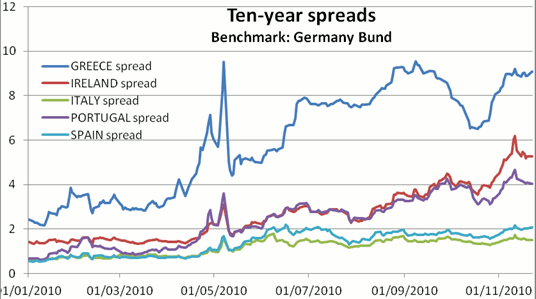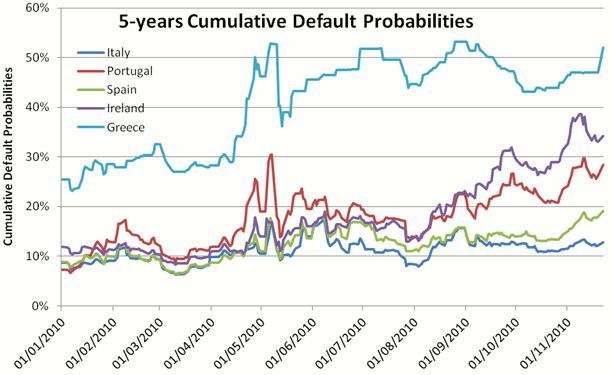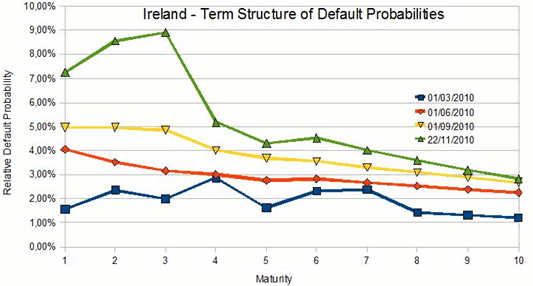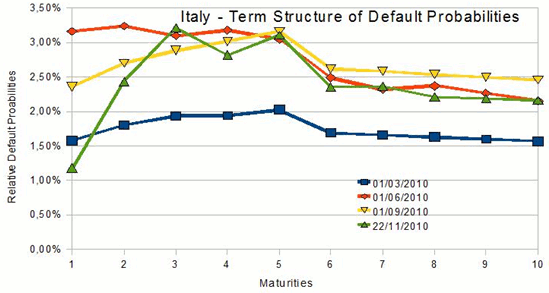By Paolo Manasse, Professor of Macroeconomics and International Economic Policy at the University of Bologna and Giulio Trigilia, Master’s student at Collegio Carlo Alberto. Cross posted from VoxEU.
Is Italy the next European country to go? This column argues that the jury is still out, although the grace period will not extend beyond three years.
Here we go again with talks of the end of the euro. This time, however, the trouble was stirred by President of the European Council himself, Mr. Van Rumpuy. The reason for alarm is well known. As soon as it became clear that Greece would miss, albeit slightly, the deficit reduction targets agreed with the IMF and the EU, the nightmare situation of Irish – and possibly Portuguese – default began to materialise. The EU, together with the European Central Bank and IMF are now keen to draw a reluctant Ireland into accepting a life-jacket package (with strings) of €80-€90 billion, that would stop, in the EU’s mind, the disease from spreading to other vulnerable countries. If it spreads to Italy, that could spell the end.
Private and public debt
It is well known that, unlike in Greece, the Irish crisis does not stem from the public sector, but from irresponsible investments by banks which, having fuelled the housing bubble, now find themselves insolvent. The government, in an attempt to bail out the banking system, has opened a chasm in the public accounts (the deficit is estimated at 32.5% of GDP), and is now at risk of going bankrupt. Unlike the deficit, public debt is quite manageable (estimated around 80% of GDP in 2010). In contrast, private debt, which covers the liabilities of households, financial institutions and firms, amounts to nearly nine times that of GDP (Italian Ministry of the Economy 2010). Clearly, the solution to the crisis will require several steps.
1. The ECB, who already finances the Irish banks at very low rates, must extend a blanket guarantee of banks’ deposits in order to avert both a bank run and capital flight.
2. A drastic restructuring of bank debt is required, balance sheets must be cleaned up and “zombie banks” must be closed down.
3. Private creditors must be bailed in sharing the burden.
4. NAMA, the National Asset Management Agency, the “bad bank” created in May for these purposes, will need more financial support.
Not surprisingly, the severe fiscal austerity plans provided by the government (cuts to 3.8% of GDP in 2010 and about 7% for each of the next two years) will hardly reassure markets. They are necessary measures, but wholly inadequate to the task of preventing the meltdown of the financial system.
Italy and Ireland
As in the case of Greece, Italy’s concern is the risk of infection. Figure 1 shows the interest spreads between bonds on Europe’s periphery and the German ten-year Bund. The Greek, Irish, and Portuguese spread, have been crawling up since April, and then shot up November. It is interesting to note that the consequences for Italian (and Spanish) spreads have so far been less severe, even if the Italian spread, at 1.3% in October 20, reached 2% in recent days.
Figure 1. Ten-year spreads

Source: DataStream
Another useful source of information is credit default swap spreads (CDS), which are updated daily (Fitch Ratings Special Report 2010). In interpreting these data one has to keep in mind a few shortcomings.
First, CDS spread are very, very volatile – much more volatile than debt yields. On May 11, 2010, for instance, the 5-years cumulative default probability of Greece fell by 11.5 percentage points in just one day. It’s hard to attribute this jump to anything “fundamental”, while it is reasonable to see it as a reflection of news or market sentiment.
Second, CDS spread reflects not only the perceived default probability of borrowers, but also the liquidity constraints of insurance buyers and sellers, the changes in risk aversion, and the optimism/pessimism about recovery rates (Amato 2005). Being negotiated over-the-counter, CDS spreads incorporate counterparty risk (Cherubini 2005), in addition to credit risk. In short, CDS spreads typically tend to overestimate bad events.
Figure 2 shows the implied (cumulative) probability of default implied by CDS spreads on European at 5 years maturity, from 1 January to 22 November
Figure 2. Cumulative probability of default implied by 5-year CDS

Source: DataStream
The good news is that the probability that CDS spreads assign to a default of Italy in the next five years (around 12.7%) is significantly lower than that of Ireland (34%) and Portugal (28%). Moreover, the surge in risk perceptions occurred in November does not appear to have significantly contaminated Italy. The correlation coefficient between Italy’s and the other countries fell from 0.825, in the period January-August, to 0.433, in September-November. The bad news is that, in the past few days, the default probability curve shows signs of crawling up.
We next exploit the fact that CDS are traded daily, at several maturities, which allows us to compute not only the cumulative, but also the conditional default probability (the hazard rate, i.e. the probability that the government will default at time t conditional on surviving until that t-1) (see Chan-Lau 2003). Figures 3and 4 show the time profile of conditional default probabilities (known as the swap curve) for Italy and Ireland, calculated at different points in time. In normal times the slope of the swap curve is flat or slightly positive, reflecting more uncertainty about more distant future . In times of stress, however, the slope typically turns negative, mirroring fears that the country may not survive in the short term. But, if it does, it will not default later on.
This is exactly what has happened in Ireland at maturities beyond three years, as can be seen from Figure 3 by comparing the term structure as of March 2010, the blue line at the bottom, to the term structure in late November, the green line at the top. Although the probability levels are much lower for Italy, the same twist in the slope of the swap curve has materialised in Italy. Compare the blue and green lines in Figure 4
Figure 3. Ireland swap curve

Source: DataStream
Figure 4. Italy Swap Curve

Source: DataStream
We interpret this evidence as suggesting that jury is still out on Ireland (and Italy), although the grace period will not extend beyond three years.


Thanks for those charts Yves. They present an interesting viewpoint and ultimately make a lot of sense. Even I can see that there are many factors which diminish risk as people and governments become accoustomed to ne circumstances.
I have a funny feeling though. I think the market may be underpricing short term risks in the Irish national scene. There are two unique factors to Ireland. First, The Irish have had less than a generation on this binge. And second, Ireland is one of the few countries which actually have a political dicotomy. Ugly though it might be, it may prevent majority support for defending the politicians. I’m not expressing this well. But, I think that protecting the status quo is the biggest risk for the citizens of any country in this situation.
I agree those are great charts, but they aren’t Yves’ charts. They were originally put in Professor Manasse and Mr. Trigilia’s VoxEU paper.
Someday history will marvel at perhaps the most insane episode in history, Tulip-mania endemic to all elites and institutions and imposed more or less by force on the entire globe for as long as it was possible, until the whole thing had its inevitable, catastrophic collapse.
Overextend and pretend to the ultimate extreme.
I picture a crumbling dam. It springs dozens of new leaks every day. Although a few loan voices are shouting, “Run for high ground!”, the lunatics below it are all pinning their bodies to the dam wall, desperately stretching to stanch the leaks with fingers, toes, foreheads, tongues.
(Meanwhile the cheap Mcmansions full of worthless expensive junk they’re trying to save are being looted by the same contractors who built the dam, the same who are yelling, “shore up the dam!”
But if the valley-dwellers saved themselves, they could build new, better homes for themselves on the high ground.)
That’s “lone”, of course. See how they’ve corrupted my spelling?
Attempter — well said. I remain puzzled why the Irish people will sit still while a few bankers plundered their country and they are expected to pay for it. It is obvious that the current govt does not enjoy the support of the public as a whole so can the public really be held responsible for any deal they negotiate. I say no.
My course of action would differ a little from what is outlined. First I would arrest all of the banker elities and confiscate their assets. People must see that there is uniform rule of law for all — rich and poor.
Second — Investigate the political elities to see why they are so anxious to sell the public down the river.
Third — Do a cram downs on the banks — I do not know if this is still possible.
Fourth — At the same time execute other steps outlined.
Yves or Richard…..or ANYBODY,
The authors mention that you can get daily updates on the 5 year CDS (Fitch Ratings Special Report). I am ASSUMING that is a service similar to bloomberg that you have to pay through the nose for. Do you know if there is a way a poor schmuck such as myself can access RECENT data on those 5 year CDS rates for FREE??? I would even settle for something that gets as recent as the last trading week’s numbers that could be dependably checked every week. Do you kind people know where I could access that for FREE online???? It would be MUCH appreciated.
I don’t know of a place where you can get free access to CDS spreads.
Specifically for this Europanic I am just following the bond yields – would that be any use to you? A lot of what goes on in sovereign CDS seems like noise to me, interesting for CDS traders, but less so if you just want the big picture.
Bloomberg has good *free* bond yield data.
You can get it easily via the nice sidebar Nemo made back when Greece was starting to blow up. It includes the peripheral bond yields for various maturities and some graphs over different timescales.
See https://self-evident.org/?p=806 for the sidebar and explanations. I favourited it back in April and find it very useful as a quick way to see how the Europanic’s going in hard numbers.
Hope this helps.
Attempter,
You are correct. Extend and pretend is the name of the game until there are no more seats on the lifeboat or the music stops, choose the analogy.
This is perpetuated, of course, by the media. Thankfully we have people like Yves who want to steer the ship in another direction prior to hitting the titanic.
For example, John Cassidy of the New Yorker writes a seemingly hard hitting piece on Wall Street :
What Good Is Wall Street?
Much of what investment bankers do is socially worthless.
http://www.newyorker.com/reporting/2010/11/29/101129fa_fact_cassidy#ixzz16Sze9gAL
But on the first page he promulgates the myth of lending:
“When a depositor places money in a savings account or a C.D., the bank lends it out to corporations, small businesses, and families”
We all know that this is not how fractional reserve banking works.
Mr. Cassidy also has a chat on Wednesday and receives a question:
————-
Andrew : It is essential to Capitalism that weak business models and ideas fail and be punished by the market (or by any other force). Since Wall Street’s survival was so critical to our economy that we could not let it fail, do you think they are punished enough as it is supposed to be in a Capitalistic manner?
John Cassidy: Theoretically, I’m with you all the way. Practically speaking, as somebody with a family and big mortgage, I don’t want to be a participant in that particular social experiment. When the Fed tried it between 1929 and 1932, things didn’t work out so great.
—————–
So, there’s Mr. Cassidy’s answer. This is probably the most typical answer of the enabling class. The top 10-15% don’t want to encourage capitalistic solutions when the capitalists fail, because of fear of losing everything.
My answer to Mr. Cassidy is that the social experiment is ongoing, and has been for 30 years. It has been implemented in South America, Russia, Japan, Ireland, Greece…etc…
There has to an alternative, and his real job in the media is to find that alternative before he loses his voice and becomes part of the experiment. He also needs to recognize that millions of
people have suffered, and will suffer as a part of the current experiment he “theoretically” is against.
Peace.
LOL State b.
you said
-” This is probably the most typical answer of the enabling class. The top 10-15% don’t want to encourage capitalistic solutions when the capitalists fail, because of fear of losing everything.”
I say it is 100% of people who have still viable mortgages and probably 50% of the ones underwater. Once we have been brainwashed, humans really hate to give up a position!
The saddest thing I ever heard was Mr. Obama’s speech (Given the day after his election), where he urged Americans to stay in their ‘homes’ no matter how hopless the situation was.
They’re brainwashed, but that comes from the top down. (Although I think 10-15% is far too big a cohort. It’s less than the top 1% by now.)
However, the people should indeed stay in their homes and keep paying the property tax.
But they should stop paying the mortgage.
Yes. But you and I know the point of the speech was that the people should keep on paying those underwater mortgages on overpriced homes. Keep the game going as long as possible. I mean, really. Why gather the same old gang if we aren’t going to play the same old game in the same old way? Right????
Are all these fancy charts based on rational expectation theory? If so, I’d bet against the assumptions. When the Irish, Italian, Spanish, etc. citizens start revolting in the street, you can bet default is inevitable. Bet on it.
“All those fancy charts”…are the voice of the market. They show the prices and yields of financial instruments of various maturities. What they show is that Mr. Mkt. thinks the longer this can be spun out, the less chance of your “riots”.
Paul: based on what? Statistical probability? Do the models account for “my riots”? I’m certainly not advocating for rioting, so don’t label them as mine. I’m merely pointing out that if the public in any of these countries start to push back against the austerity and tax burden requirements associated with the “recovery”, the rate of default probability will start to rise significantly. Stand by for future developments.
Well what do you know: From Now Public: Today thousands of people marched in protest against the Government’s austerity program. The austerity package, announced on Wednesday, includes proposals to cut the minimum wage, slash the number of public sector jobs and increase taxes in order to save 15bn euros over the next four years.
The march began from Wood Quay shortly after 12 noon and the protestors made their way along the north quays to the General Post Office (GPO) on O’Connell Street.
Let’s see if the default probabilities change for Ireland in the near term.
Portugal is where Greece was last February. Once markets start raising the specter of default, borrowing interest rates go up, which raises further the chance of default, which raises interest rates even more, and so on.
So, for the markets, default of an over-leveraged entity is a self-fulfilling prophecy and after a certain point reality does not even matter. This can happen to anyone who owes too much and cannot print money. Do you get it Italy and France? I think they do.
Does a Bear shit in the Woods? Is the Pope Catholic?
Its already a done deal that the cascade will work its way to Italy, thence to France and Germany after that.
What is incorrect is labelling this as “contagion”, as though it were some type of spreading virus jumping from one economy to the next. This is not the case at all. All these economies are BK all on their own, they don’t need to be infected to become sick, they are already sick. In fact, they are already Dead, they just don’t know it yet so they operate like Zombies.
The only valid questions to consider revolve around the timelines involved for each successive collapse and exactly for how long liquidity swaps with the Fed will be able to keep the European banking system from locking up.
Will the Irish crisis spread to Italy? You must be joking Yves. Even the Kindergarten students in Germnay can answer that question.
RE
You are missing a very key fact. Italy’s high debt to GDP ratio is due to government debt…which is held by Italian investors, primarily households. Italy has a very high savings rate and IIRC has no or very low net debt. Unlike Greece, Portugal, Spain, and Irish banks, Italy is not at the mercy of international investors.
All I have to go by really is that nice chart produced by the BIS showing the counterparty debt relationships between the Euro states, which as of when the chart was produced (2009 I believe) shows Italy with the Biggest Bubble on the chart, with $1.4T in Foreign held debt, $511B of it to France which then represents 20% of the GDP of France. Sense a problem here?
I don’t buy the idea that most Italian Debt is held by Italian Households, any more than I buy the idea “Households” are buying up USTs these days. Even if it is true though, it doesn’t take much to start a downward cascade once any large institutional investors start dumping any kind of bond onto the market. Then even the locals who hold the debt will try to dump it also. Nobody sits and watches their portfolio drop in value without trying to unload a losing bet, even if the bet is on their own country.
Anyhow, we still have to work our way through Portugal and Spain before we get to Italy, so its probably a couple of months at least coming down the pipe. Unless of course we get liquidity lockup through the market in the interim, in which case all bets are off.
RE
as far as I know, itaaly runs a huge current account deficit, 3rd largest in the world, immeditately followed by france, 4th largest in the world. so italian internal savings cannot save italy.she has to find external debt to finance its imports.
how sad…
OOPS. I guess we don’t have to wait until Portugal and Spain go completely in the crapper! Did you catch Ambrose’s blog today?
“Contagion strikes Italy as Ireland bail-out fails to calm markets
The EU-IMF rescue for Ireland has failed to restore to confidence in the eurozone debt markets, leading instead to a dramatic surge in bond yields across half the currency bloc.”
Dominoes falling fast now!
RE